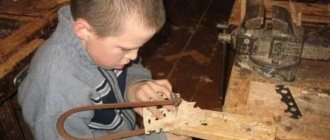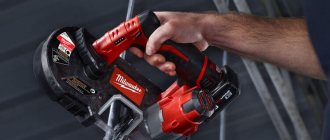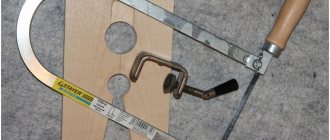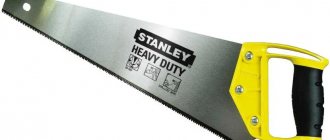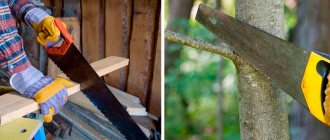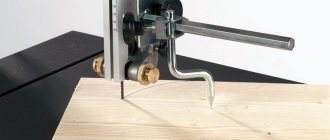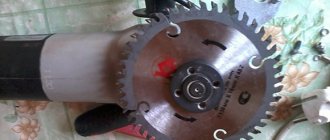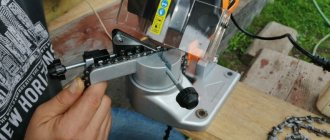- Application of tapes
- Typology of paintings
- Saw maintenance
- Features of breeding tape webs
- How to properly sharpen a blade? Method 1: Full profile sharpening
- Method 2: Sharpening the tooth edges
A properly sharpened band saw for metal and wood is the key to productivity and long service life of the tooling. As a rule, such services are provided by special organizations, but if you know the sequence of actions and features of the process, you can sharpen a saw that has become dull on your own.
Design features of band saws
- Band devices intended for cutting wood are made from alloy tool steel, which has a hardness of 40 to 46 HRC.
Elements of a tooth.
- The width of the cut (kerf) of band tools is much smaller than that of disk analogues. When cutting cheap wood, this point is not so noticeable, but when cutting valuable and exotic types of wood, it is critically important.
- The machine can cut workpieces of any size. At the same time, the band tool works quickly and creates a high-quality cut.
- There is very little waste (shavings, sawdust) when using this type of saw.
Note! In order for the machine to always work stably and efficiently, its maintenance should be approached with the utmost responsibility. Sharpening and setting of band saws for wood must be carried out in a timely and competent manner.
Profile, teeth and sharpening angle
International classification of tooth profiles.
Tape devices have different tooth geometries, which depend on the type and characteristics of the materials being cut. Wood tools can be carpentry or dividing. There is a third type, designed for sawing timber and logs. All these subspecies have their own parameters and shape of the teeth.
The sharpening angle of wood band saws is selected by the manufacturing company based on several points. The main one is that the harder the material, the smaller the rake angle should be. Below is a table with the main parameters of the saws.
Saw characteristics | Carpentry fixtures (1 profile) | Dividing analogues | For cutting logs and beams (4 profile) | ||
| 2 profile | 3 profile | ||||
| Thickness of the canvas, mm | 0.6-0.9 | 0.9-1.2 | 0.9-1.2 | 1.4-2.2 | |
| Width of the canvas, mm | 10-60 | 50-175 | 50-175 | 230-350 | |
| Teeth pitch, mm | 6-12 | 30-50 | 30-50 | 50-80 | |
| Height of teeth, mm | 2-6.5 | 9-13 | 7.5-15 | 16-24 | |
| Rounding radius at the cavity, in mm | 1.5-2.5 | 3-4 | 3-4 | 5-8 | |
| Rear angle, in degrees. | 35 | 20 | 15 | 12 | |
| Sharpening angle, in degrees. | 50 | 45 | 45 | 53 | |
| Front angle, in degrees. | 5 | 25 | 30 | 25 | |
This is interesting: How to make a spot welder from a regular microwave
Recommendations
Machines that produce adjustment of two teeth at once are manufactured in the following types:• together with a sharpening machine;• separately only an adjustable machine powered by an engine;• separately only an adjustable machine with manual feed in the form of a wheel (photo 1) or lever.
Photo 1.
Adjustable machine with manual feed in the form of a wheel Machines for this option are most strongly advertised by sellers, because they supposedly should make the work of the sharpener easier by setting two teeth at once on both sides of the band saw. This is a very good advertising “noodle” for the ears of those who have never set up band saws themselves.
Those who have at least once prepared a saw for work know very well that each tooth on the saw is set individually. The tooth is always retracted by the pusher by an amount greater than the required setback.
When the pusher is pulled back, the tooth always springs back a certain amount.
Moreover, even for one saw, the springing back of each specific tooth can fluctuate between 5 and 25 indicator units. Therefore, the sharpener almost always has to make two or three presses, often to different indicator values each (that is, with different force), to obtain the required setting value.
There are also teeth that spring worse than others and even with one or two presses before the indicator reads, as on well-spring teeth, they remain at values greater than the required set, and they have to be specially bent back. Now it should be clear to you that one It is simply impossible to separate two teeth by pressing well at once.
There are also teeth that spring worse than others and even with one or two presses before the indicator reads, as on well-spring teeth, they remain at values greater than the required set, and they have to be specially bent back. Now it should be clear to you that one It is simply impossible to separate two teeth by pressing well at once. But the machines sell well, and some are even happy with the results.
When setting the saw on such a machine, you should always know: you will never get a guaranteed good setting of the band saw.
Divorce will always be unpredictable. With small feeds of the carriage, a random batch of saws with more or less equally spring-backed teeth, sometimes it is possible to saw normally with a new clean mechanism. But problems inevitably arise later.
But they begin to look for the cause of these problems anywhere, but not in the divorce, believing that it is very good. Manufacturers don’t even put indicators on almost all of these adjustable ones. Explaining this by saying that you install everything once, and then just move it apart: the hammers always hit the same way and there is no need to check.
And you check and see for yourself how large the spread in the adjustment values actually is. In addition, the accuracy of the resulting adjustment in these machines is strongly influenced by the same reasons as in classic ones: dirt getting into the mechanism, risks on the pusher stop and support plates . The height of the part of the tooth being set has a particularly strong effect.
The sharpening angle of band saws in winter.
Do-it-yourself cutting and sharpening of wood band saws
Despite numerous attempts to use saws from other manufacturers, Wood-Mizer was unable to find a saw that could produce a quality cut.
Then it was decided to invest in the development and creation of an innovative product - a bandsaw blade designed specifically for wood.
It was experimentally discovered that the best alloy is not the cheap steel used by other saw manufacturers, but the more expensive alloy from which the famous Wood-Mizer DoubleHard series saws are now produced. Also during the research, an optimal 10/30 tooth profile was developed, which today is the standard in the woodworking industry. Despite its apparent simplicity, in reality the Wood-Mizer band saw is an intellectually capacious product that has been tested on millions of sawn cubic meters of wood.
The geometric parameters of the saw are strictly balanced and optimally match the type of wood being cut, engine power and a number of other factors. Wood-Mizer's engineering team is continually working to develop and improve this product.
If previously Wood had one tooth profile, now there are four options available. Previously, saws with a width of 32 mm and 38 mm were manufactured - now saws with a width of 35 mm, 45 mm and 50 mm have been added to them. That is why the Wood-Mizer saw is copied - after all, only the best is always counterfeited. Today, the Wood-Mizer band saw is a product used in 220 countries, on more than 50,000 band saw machines.
Today, the Wood-Mizer band saw is a product used in 220 countries, on more than 50,000 band saw machines.
And everywhere in the world, this saw cuts wood consistently and with high quality, and its service life provides users with minimal tool costs per volume of sawn products.
Tooth Profile A - Tooth Pitch
Preparing the device for work
With constant use of the tool, a decrease in the quality of the cutting edge is inevitable. It becomes dull, and the width of the teeth is reduced. Based on this, sharpening a wood saw and setting it up are necessary components of the maintenance of a band saw machine.
It should be noted that the setting of the teeth should be carried out before sharpening them, and not vice versa.
Tool layout
Application of an adjustable machine.
Setting is the process of bending the teeth to the sides. This operation is necessary to ensure that the saw blade does not clamp in the workpiece, and also to reduce friction during operation.
There are 3 main types of breeding.
- With the classical method, the cloves are bent left and right in strict order.
- With the stripping method, every third of the teeth remains in its original position. It is optimal for devices designed for cutting particularly hard wood.
- With a wavy setting, each tooth is given its own separate bend value. In this case, the profile of the canvas takes on the appearance of a wave. This method is the most complicated.
Note! When setting, you should not bend the entire clove, but only a third or two-thirds of it from the top. Manufacturing companies advise performing the operation so that the bending range is within 0.3-0.7 millimeters. The work is carried out using a specialized spreading tool.
Sharpening the saw
Elbor circles having different shapes.
Before sharpening a saw blade for wood or a band tool, keep in mind that more than 80% of incidents with damage to devices (including their rupture) occur due to non-compliance with work standards.
- The need for surgery is determined visually. In this case, you should pay attention to the condition of the teeth and the quality of the cut walls (for example, their increased roughness).
- The circles for the point of the band tool are selected based on the degree of hardness of the teeth. To work with tools made of tool steel, corundum discs are required. Bimetallic saws are sharpened on borazone or diamond wheels.
- The shape of the emery for belt devices must be selected based on their parameters. Cup, profile, plate, and flat circles are known.
- Before carrying out the operation, it is necessary to turn the saw out and let it hang in this position for about 10-12 hours.
Manual tool maintenance.
The wood saw sharpening scheme should take into account the following provisions.
- Metal removal along the profile of the teeth should be uniform.
- Excessive pressure from the sharpening device must be prevented. It can lead to annealing.
- The profile of the blade and the height of the teeth must remain unchanged.
- Liquid cooling must be provided during the operation.
- There should be no burrs on the teeth.
Pay attention! The theoretical instructions for sharpening band saws on wood indicate that it should be done either on the front side of the teeth, or on both the back and the front. In real life, most specialists and amateur craftsmen perform the operation only on the back side, because it's more convenient.
Sharpening methods
The photo shows automatic full-profile sharpening.
You can prepare a tool for work using special sharpening devices (for example, machines with wheels of different materials and shapes) or manually. Before you properly sharpen a wood saw, you should learn the basic methods for carrying out this operation.
The first method is full-profile sharpening.
- It is of the highest quality, the operation is carried out on an automatic machine.
- Elbor emery, chosen exactly in shape, passes the entire surface of the interdental cavity along with the accompanying planes of adjacent teeth in one movement.
- The creation of angularities at the tips of the teeth is completely eliminated.
- A relative disadvantage of such sharpening is the need to have at your disposal the appropriate number of wheels for blades with different profiles.
A tool sharpened along the edges.
The second method is to sharpen the edges of the teeth.
This can be done either manually or using a professional machine.
- Having chosen a machine, you need to decide on the wheel to be used. As a rule, it is flat. Specialized sharpening devices should only be used when there is a lot of work to be done.
- In domestic conditions, sharpening is best done with your own hands - using regular mechanical sandpaper or using an engraver. When performing the operation, do not forget about personal protection and use gloves, a mask or special glasses.
Working with an engraver.
- When you and your neighbors don’t have an engraver, machine, or emery, you can sharpen a band saw using the traditional folk method - using a needle file.
Recommendations
For clarity, you can combine these sheets. Please note that a data discrepancy of just 0.5° already leads to inaccurate profile grinding. And an inaccurate connection of the left straight line also leads to a change in the pitch of the saw. Now imagine that the sharpener should do all this not on paper, but on a rotating circle, where it is even more difficult to maintain the exact dimensions.
But it is not enough to form it once. It is necessary that when re-sharpening after sawing, the profile of the end of the wheel should be exactly the same as during the previous sharpening, which is practically impossible.
Therefore, it is not so important what quality you sharpen around. Even if you have a very good wheel and you can sharpen a set of band saws for an entire shift without additional profiling, you will almost never be able to repeat exactly the same profile of the end of the wheel the next time you sharpen it, which means you will not be able to accurately sharpen the profile of the saw teeth after its dullness. Now you understand why accurately shaping the end of a circle profile is not just difficult, but an extremely difficult task.
To somehow make its solution easier, you can sharpen with bakelite reinforced circles 3-4 mm thick. But they are difficult to find in the required quality.
Therefore, the profile of the circle must be monitored very carefully. Otherwise, this leads to the following changes in the body of the band saw: A change in the radius at the base of the tooth, which entails a change in the pitch and the impossibility of normal sharpening of the saw on the next pass. The circle begins to unevenly cut into the front edge without touching the back, or vice versa, that is, it becomes impossible to grind the full profile of the saw at once.
The sharpener tries to sharpen at least the cutting edges of the teeth in just two or three passes, but at the transition point a microhump or microcavity appears, which leads to the appearance of microcracks, and microcracks that have already arisen during sawing are not removed, which leads to premature rupture of the saw along the body. Changing the sharpening angle, tooth height, cavity shape, which affect performance
Band saw alignment and sharpening table.
Rules for sharpening band saws for wood
This can significantly reduce the friction of the blade and prevent it from jamming. To ensure free movement of the blade on the walls of the material being cut, its width must be greater than the thickness of this material.
Types of band saw wiring The wiring can have several varieties. It may have different names from different manufacturers.
Most often it can be: Standard, which is characterized by the opposite bending of the cutting elements in various directions. It is most often used for band saws that cut hard materials. Wavy, which belongs to the category of complex structures.
Divorce in this case has a variable meaning.
In this case, a kind of wave is formed. The unraveling consists in bending not the entire canvas, but only a certain part of its top.
The parameters are determined strictly by the tool manufacturers. Their range is from 0.3 to 0.7 millimeters. Protective. Setting consists of bending two teeth.
At the same time, the third one remains in place. Intended for band saws for processing particularly hard materials.
Every third tooth is shaped like a trapezoid. The location is the center of the canvas.
With its help, the most correct direction of the saw blade is ensured.
Woodworking machines are characterized by the universal design of the sawing tool. The setting for processing soft rocks should be characterized than in equipment for processing hard rocks. But the spread should not be such that there is a wedge in the center without a cutout.
The spread must be characterized by the same arrangement of all cutting elements. The teeth must be set so that the deviation is no more than 0.1 millimeters.
If the saws are unevenly positioned, this will cause the band saw equipment to move to the side during operation.
During operation of the canvas, its rupture is very often observed. This is explained by the fact that its sharpening is poorly carried out.
Application of tapes
The key component of every band saw is the band saw (blade). Band saws are widely used when working with wood, metal, rubber, plastic and various flexible materials.
There are three types of these products.
- Manual tape devices - these machines can be called household ones; they are most often used at home.
- Desktop modifications - these units are often purchased for small industrial facilities, woodworking companies, and workshops.
- Stationary units - such installations are classified as professional; they are used in large industries, factories, factories, large workshops, and so on.
Useful tips / How to work correctly on band sawmills
But by themselves they do not guarantee the quality of lumber and will not allow the saw to serve for a long time if sawmills with serious technical shortcomings are used in production. For example, if the rollers are made with a cone, or they became conical because the saw sharpened them, then even with proper sharpening and setting, the saw begins to look for its place in the log.
This will happen because the rollers are at an angle.
If the pulleys on the sawmill are spread apart and are not in the same plane, then the saw does not flare clearly in the middle, but from the sides, and then the tension goes to the edge of the band blade. This also reduces the service life of the saw. Read also: How many kilowatts does a welding inverter consume? So the role of correct wiring and sharpening of the saw is, of course, great, but these factors do not determine 90% of high-quality sawing, as is commonly believed.
It’s just that the saw itself will not be able to cut perfectly smoothly and not break down for a long time if, for example, a rigid tension is used at the sawmill. If you are just starting your business and have not yet had time to familiarize yourself with all these nuances, we recommend that you contact those who work in the market not the first year. Phone number of the central office of the Emerald Forest company in Novosibirsk.
Contact us and we will advise you on the choice of equipment based on your needs and your budget. Optimal conditions are our own workshop or other premises for processing such materials.
The minimum area of such a building is 18 m2. The simplest way out of the situation is to “dislocate” the sawmill in the open air, but it has a big drawback. These are sawdust flying into their territory, as well as falling onto neighboring areas.
In this situation, the most reasonable solution is to build a solid fence around the unit.
The material for the barrier can be plywood or polycarbonate.
A large canopy placed over the sawmill is also not bad, since the roof will allow you to work in any weather conditions.
Typology of paintings
The basis for the division of saws of this type is the material of manufacture and the elements being processed. In accordance with such aspects, the following types of canvases can be distinguished.
- Wood saws. The key materials for their manufacture are carbon and alloy steels; their hardness reaches 40–45 HRC. All teeth are subject to mandatory hardening with high-frequency currents. It should be noted that this blade material can be used for cutting thin non-ferrous metals or carbon steels.
- Canvases for metal. Such tools are made from high-speed or spring steel (cobalt and tungsten are added to the structure). These saws already carry a strength of up to 69 HRC. To obtain high hardness and broad capabilities, stellite or other types of durable alloys can be welded onto the teeth.
Teeth and sharpening angles
Band saws have different tooth geometries due to the different types and properties of the material being processed.
If we consider wood, then the teeth are divided into:
- - carpentry;
- - divisive;
- - for sawing logs.
As for sharpening angles, the manufacturer determines this parameter. Basically, it is accepted that the harder the material, the smaller the rake angle.
For metal band saws, the teeth are usually shaped either standard or with a positive rake angle. Let me clarify this point a little: the standard tooth shape is used for sawing thin-walled material, and the shape with a positive rake angle, as you might guess, is used for cutting thick-walled material.
I suggest looking at a small picture that can explain what profiles a tooth can have and where they, these same profiles, are applicable.
In addition, the pitch of the teeth is important. So, for example, for a thin-walled material you should use a tool with a small number of teeth, and for thick-walled material, on the contrary, with a large number of teeth per inch.
Now let's take a look at the picture, in which we can clearly see how saws with variable tooth pitch differ from saws with a constant tooth pitch.
Often, saws are made with variable pitch in order to eliminate the resonance effect.
Next, I propose to find out what types of band saw layouts there are.
This is interesting: Characteristics and passport of the 2M112 desktop drilling machine
Characteristics
Sharpening a band saw has a number of the following features:
- It is prohibited to use abrasive discs and hand-held sharpening tools with uneven wear on the working surface;
- when turning, it is important to perform all movements evenly, without jerking or uneven movement of the tool, since there is a high probability of violating the geometry of the teeth;
- the machines used must have liquid cooling to prevent overheating of the equipment and tape;
- after completion of the work, there should be no burrs or chips on the surface, as they can negatively affect the quality of cutting;
- when sharpening a tool for winter use, it is important to increase the angle of inclination of the teeth to 900, however, it is unacceptable to use such a tape for woodworking in the summer due to increased loads on the cutting edge;
- when sharpening on machines, you need to make sure that the disk is positioned correctly relative to the belt profile;
- the speed of the grinding disc is selected so that the metal is not heated red hot, since in this case it will lose its strength properties;
- if the band saw has been operated without maintenance or the recommended service life has been exceeded, then when turning you will need to remove a larger layer of metal in one pass;
- to control the quality of tool sharpening, it is recommended to use a new tape as a standard;
- It is prohibited to change the factory shape of the teeth, as the saw will become unsuitable for use;
- the need for sharpening is determined by the degree of wear of the teeth by 35% of the original dimensions.
Device for setting teeth
To cut teeth with a pitch of 0.5 mm, the ratchet wheel is replaced. The replaceable matrix 11 is attached to the body 1 with screws 12 and installed using a stop 13. When installing a new tape, the upper roller is moved away from the lower one using a special lever. With 116 strokes/min of the slider and a tooth pitch of 6 mm, the device cuts teeth on a 41.76 m long strip in 1 hour. Correct tooth spacing is of great importance for the productive operation of band saws. To set the teeth of band saws, a device is used, the operating diagram of which is presented in Fig. 14 [8]. The device is driven by the rotation of the flywheel 1, mounted on the crankshaft 2. On the latter, ring-bearings are freely located, in which curved levers 3 and 4 are attached to the threads. When the flywheel rotates, they receive a reciprocating motion. At the end of lever 3 there is a square with a freely hanging pawl 5. When lever 3 moves to the right, the pawl rests on the tooth of the saw blade 6. With one turn of the flywheel, the saw moves two teeth. The pawl and the square are hinged, so when the lever moves back, the pawl rises and slides along the teeth of the saw. Levers 4 are elements of the gear setting mechanism (the second lever is located on the back side of the housing). Levers 4 are pivotally connected to the crank axis of the cam 7. The levers return to their original position by springs 8. When the flywheel rotates, the levers 4 rotate the cams 7, which push the punches 9 towards each other. Two adjacent saw teeth bend in different directions (move apart). Springs 8 return cams 7 and punches 9 to their original position. The angle of the teeth is adjusted with nuts 10 and by deepening the threaded end of the levers into the rings on the crankshaft. The tooth set angle is 15° in both directions. The amount of feed of the pawl 5 is adjusted by nut 11. The mechanism for installing and securing the band saw has two plates that make up the body of the device, and a wedge 12 located between them. The wedge moves in the body, and the teeth of the set saw always protrude above the body by a certain amount. At the Volgograd Tractor Plant they use a device for setting the teeth of band saws. The device operates by hand drive and consists of two disks with shoulders on which a band saw is mounted. One of the disks is movable to tension the saw. The adjustment is carried out by two cams using a pawl, a lever with a roller, copiers, a handle and levers. An automatic machine is used for cutting and setting the teeth of band saws [54]. Teeth cutting is done on a steel strip of any length, which is then cut into measuring tapes. When refurbishment of band saws, the teeth are cut again. The machine can be installed on a separate frame, table or workbench; its overall dimensions are 380x320x250 mm, weight 16 kg; it is equipped with an electric motor with a power of 0.37 kW, with a shaft rotation speed of 1400 rpm. On the plate 1 of the machine (15) two brackets 2 and a support bar 3 are installed. Supports 4 are attached to one bracket, in which a worm 5 carrying ball bearings and a driven flywheel pulley 6 are installed. On the other bracket is mounted the eccentric 7 of the pusher 8 of the feed mechanism and gear wheel 9. The feeding mechanism consists of three supports 10-12, on which are placed a worm pair 13 and 14, a drive roller 15 for feeding the tape blank, a pressure roller 16, a pressure roller lever 17 and a screw 18 that regulates the degree of pressing of the pressure roller. To move the workpiece per saw step, a replaceable ratchet 19 is mounted on the worm 5. A drive gear 21 is installed on the shaft 20, which meshes with the eccentric gear of the feed mechanism pusher, cam disks 22-25, intermediate bushings 26 and 27, and a worm wheel 28. A combination stamp (16) is installed on the support bar 3; one of the stamps is used for cutting out teeth, and the other for setting teeth; the stamps are mounted on plate 1 between two posts 2 and 3. On the base of plate 1, together with the die-cutting die matrix, two strips 4 and 5 are installed. Between the die-cutting die matrix and the guide strip 6 there is a clamping device strip 7. The device is kinematically connected to the punch of the cutting die using two rollers 8 and 9 of guide bars 10 and 11, between which a spring 12 and a pushing head are inserted. A rubber ring 14 and a metal ring 15 are put on the bar 11, with which the tape is pressed while cutting the teeth. For lateral clamping of the tape, a clamping device is mounted in the hole of the strip 4. It consists of a retainer 16, a clamping bar 17 and a spring 18. The pushing head serves as a guide sleeve into which the spring 19 is inserted. The tape is secured with a nut 13. The nut 20 of the pushing head rests on the metal ring 15 of the rubber ring 14. To release the tape after cutting and moving It is placed on the new section by spring 12, which returns the clamping device to its original position. During operation, the pushing head of the punch slides along a bronze bushing 21, pressed into the bar of posts 2 and 3. Depending on the clamping force of the tape, it protrudes above the bar by one or another amount. The die for setting the teeth does not have a clamping device. Punch 22 is inserted at one end into the pushing head 23, and at the other into the bar 24. Its position is adjusted by a nut 25. A spring 27 is installed between the nut 25 and the guide sleeve 26. The pushing head of the punch slides along the guide sleeve 28, pressed into the bar 29. Combined die installed on the stove and covered with a casing. To thicken the teeth of band saws, the DIXA device (PNR) is used. The distance between the teeth undergoing thickening is 17 mm, the minimum tooth height is 9 mm, the maximum saw thickness is 3 mm. For lateral profiling, leveling and grinding of flattened teeth of band saws, the DHCA-20 machine (PNR) is used.
Saw maintenance
To maintain the blades, it is not enough to sharpen the teeth; they also need to be set apart. These two procedures are performed in order of succession: they begin with setting the teeth, and end with sharpening them. This chronology of work must be strictly observed. Dilution is carried out in order to reduce saw friction in the process of cutting a particular material (wood, metal, plastic, etc.). There are several methods of breeding, which depend on what elements need to be obtained after processing and the strength of the starting piece.
Let's start sharpening
To service saws, it is not enough to sharpen the teeth; you also need to separate them. Both of these operations are performed sequentially, starting with spreading the teeth and ending with sharpening. It is necessary to strictly adhere to this sequence of work. The layout is done in order to reduce the friction of the blade against wood or metal (or other material being processed). There are several layout options, which depend on what parts are required to be obtained after processing and the hardness of the original workpiece.
Otherwise, the tape may get jammed. Most often, alternate wiring is used. In this case, the teeth are bent sequentially in different directions from the vertical plane of the tape. Wiring for cleaning surfaces is less common. Its distinctive feature is that every third tooth does not bend, but the first two bend in different directions. The most complex, but relatively frequently used, is the wavy layout. This type of set differs from the others in that each tooth has its own set angle. Separating the teeth at home can be easily done with pliers. To do this, you need to fix the tape motionless and move your teeth apart while working, carefully maintaining the angles. When setting, not the entire tooth is bent, but only 2/3 (sometimes ½) of its length.
When the tape is spread apart, sharpening can be done. To do this, you need to select the necessary grinding wheels and a machine for them. The composition of the circle material is selected based on the hardness and material of the blade. It is also important to choose the shape of the sharpening stone - it depends on the type of cutting edge of the tape. It is the shape of the sharpening stone that determines the angle of “sharpness” of the tape. Sharpening work should begin by installing the whetstone on the machine, securing it to it, after which the saw blade is fixed motionless in special clamps. The sharpening process itself is simple: the whetstone is untwisted (mechanically or electrically) and then lowered onto the blade (or moved closer). This is how one tooth is sharpened, then the stone is moved to the next one. When the entire cutting edge within the sharpening stroke is sharpened, the blade is shifted to sharpen the raw teeth. To prevent re-sharpening, use a marker to mark the “starting” teeth.
Sharpening band saws with a narrow abrasive wheel.
Currently, this method is becoming a thing of the past. Machines for sharpening band saws with a bakelite or ceramic wheel have many different adjustments and it is quite difficult for a novice master to take into account all the nuances, as well as avoid mistakes. These include burns, rough surfaces (burrs), lack of bosom grooves, and the formation of irregular angles of band saw teeth. As mentioned above, all this leads to the inevitable failure of the cutting tool.
Perhaps the only advantage that can be highlighted is the relative low cost of machines and equipment.
Factors influencing the correct sharpening of band saws when using narrow abrasive wheels:
- technical factor (correct adjustment of the machine along all axes, entry and exit angles, groove height, metal removal depth)
- instrumental factor (correct selection of grinding disc, formation of the angle of attack of the disc, grain size, etc.)
- the human factor (often laziness and lack of proper attention on the part of the master plays an evil role and leads to sad consequences)
Sharpening band saws with a borazon (CBN) disc.
Preparing cutting tools for use on machines using diamond tools is a modern and reliable way to avoid problems when sawing sawlogs and obtaining the correct geometric dimensions of lumber.
Unlike narrow circles, CBN exactly repeats the profile of the teeth of a band saw. Constantly rotating on an axis, the circle makes up and down movements, grinding through the sinus, corners, relieving tension in one pass. The process occurs automatically, the band saw is pushed by a special drive pusher.
The accuracy of sharpening depends on the correct selection of the grinding wheel profile. The most commonly used band saw profiles are:
The 4°/32° profile is a rarely used profile, designed for extra-hard wood, dry wood and for use in the cold season. Profile 9°/29° profile is designed for hardwood in the cold season. The 10°/30° profile is a universal profile, most often used in the southern and middle zones with mild climates. 13°/29° profile is more suitable for soft wood, increases cutting speed
The service life of CBN discs depends on the following factors:
1) the correct selection of “saw profile - sharpening disk profile” (if this point is violated, the sharpening disk will “go bald” in places where there is a discrepancy)
2) quality and layer of borazon coating
3) reliable supplier (we supply only high-quality CBN grinding wheels, proven by experience and time, from manufacturers such as Wood-Mizer and Astron)
4) the presence of a cooling system and the correct choice of coolant
5) correct adjustments
6) condition of sharpening equipment.
We would like to tell you about typical errors that occur during the process of sharpening and routing the tape.
1.
Such cracks occur due to improper installation of guide rollers. As a result, the back of the saw constantly rubs against the side of the roller during operation.
2.
In this case, the tape quickly becomes dull. The cause of this type of error is too much pressure on the grinding wheel during the sharpening process.
3 and 3a. It is visually noticeable that when sharpening the grinding wheel passes through an incomplete tooth profile. There is an error in setting the angle of the sharpening machine head or in the profile of the sharpening stone if a non-borazon CBN disc is used.
In addition, the reason may lie in the development of the eccentric of the sharpening machine. Cracks appeared in the place that was not machined.
4 and 4a.
Zero angle of attack - the belt rattles a lot during operation, which leads to vibration of the sawing head. In this case, cracks appear on the body of the saw in the place indicated by the circle.
The cause is incorrect installation of the sharpening machine head. With a very small (4a) tooth height, the tape begins to “wave” due to the fact that the sinus is not large enough to throw out sawdust, which in this case is very small (dust).
5.
The tooth is not sharpened completely. The reason for this is the off-axis installation of the sharpening machine head in relation to the clamp. The tape will quickly become dull.
6.
Too much tooth set. The cutting edge of the tooth (top) is not equidistant from the edge of the groove of the tape, which becomes dull very quickly. There are significant jerks of the head during cutting.
The service life of a wood band saw directly depends on the quality of its sharpening. It can be done either independently or using the services of specialized companies. In the first case, it is necessary to familiarize yourself in detail with the technology and a number of features.
Sharpening methods
Sharpening a band saw for wood can be done in one of the following ways:
- full profile;
- only edges.
Full profile turning has the following advantages:
- operations are carried out with high precision, as they are performed on automated machines;
- specially shaped emery passes the entire surface of the space between the teeth simultaneously with the planes of adjacent cutting edges in one movement;
- tops of regular shape without angularity are formed.
Sharpening of edges can be done in the following ways:
- A machine with a flat abrasive wheel or a special shape is selected, depending on the profile of the cutting edges.
- At home, it is recommended to carry out processing with an engraver or regular sandpaper of suitable sizes. To operate, you will need to wear goggles and gloves.
- In the absence of tools from points 1 and 2, the use of needle files is allowed.
Fabric material and its parameters
Band saws are used for a variety of woodworking projects. Depending on what specific work the blade is performing, the teeth are sharpened at a certain angle, and their angles of inclination also differ significantly.
Band saws are considered a highly specialized tool, which is intended for woodworking as part of a machine or various complexes (sawmills). A special feature of this tool is the blade, which has the shape of a closed tape. Depending on the tasks performed, such saws may have teeth sharpened at different angles, with different inclinations, and to perform some work, the cutting edge must be flat (toothless) and sharply sharpened. These woodworking machines are capable of making neat and thin cuts, so they are often used for finishing work on cutting boards and when working with valuable types of wood. The capabilities of such tools are great - they can make cuts at almost any angle and in any planes, and not just longitudinal-transverse cuts. They have a number of advantages: high speed of woodworking, long service life of cutting edges and tapes (subject to operating rules), evenness, accuracy and symmetry of cutting lines
Types of band saw teeth: a, b – simple triangular; c, d – triangular sparse and with wolf teeth; d, f – rectangular, hypotenuses facing each other and sparse.
In order to keep the tool in working condition and always ready for use and at the same time provide a high-quality cut, you should regularly sharpen the cutting edge and monitor its condition for wear. Otherwise, instead of a short and simple procedure for sharpening the cutting edge, you will have to do a complex and lengthy full sharpening.
For proper maintenance, it is necessary to know the material used to make the tool. Typically, tape blades are made of steel 9ХФ and В2Ф. Their hardness ranges from 47-58 Rockwell points. Such hardness cannot ensure long-term retention of an edge sharpness. Steels with great hardness are extremely rarely used, and it is difficult to sharpen a blade harder than 60 points. An example of a highly hard blade is a blade made from steel 100Х18В4 (or its imported analogue), the hardness of which can reach 100 points. This saw is used for processing metal parts and sheet metal. Steel 100Х18В4 is quite expensive, so only the edge with teeth is made from it (the width of the strip is about 5-7 mm), and they are soldered to the rest of the blade using a laser. It is recommended to sharpen such blades in specialized centers or professional workshops, since sharpening them in a garage is difficult and requires special training and expensive tools.
It is recommended to monitor the degree of edge wear visually, while looking not only at the edge itself, but also at the quality of the cuts. A dull edge makes an uneven cut, possibly jagged, when working. Another way to monitor web condition is to strictly control machine operating time. To do this, the time of cutting the workpiece with a sharp blade and a dull one is recorded and compared with the time of the current work.
There are two main ways to sharpen a band saw.
1 way
Referred to as full-profile sharpening. It is produced on an automatic machine, which immediately means that the sharpening will be of high quality. The principle of sharpening is based on passing the entire interdental cavity with the corresponding surfaces of adjacent teeth in one movement with a CBN wheel, which is directly selected according to the shape. It follows from this that we will not get angular shapes at the base of the teeth. This is simply out of the question.
Wheels are often used, the abrasive of which can be electrocorundum, CBN or diamond sputtering.
Perhaps the only significant disadvantage of this method is that different saws require different circles.
Method 2
Characterized by sharpening of the tooth edges. It can be done using a machine, then the circle is selected again. Manual processing is carried out by an engraver or on a conventional machine in compliance with safety precautions, or using a needle file (its essence is to make several movements along the front or back surface of the teeth)
To sharpen a band saw with your own hands, you need to:
- — eliminate strong pressure on the circle;
- — ensure uniform metal removal along the tooth profile;
- — ensure the preservation of the height, as well as the profile of the tooth;
- — control the absence of burrs;
- — use coolant.
If there are nicks on the surface of the tooth, the saw will quickly become dull. Therefore, it is important to have a smooth tooth surface. It is also necessary that the radius at the base of the tooth is maintained. This is necessary to prevent cracks and tearing of the fabric.
The saw should be sharpened as soon as there is noticeable force to move it in the wood. Most woodworkers are happy to sharpen their tools, but may call a professional if the teeth need to be set. The alignment should be done after 4-5 sharpenings or if the saw “moves away” from the intended direction due to incorrect alignment. Electrically hardened teeth cannot be sharpened by hand, and dull replacement blades for fine work are simply thrown away.
How to properly sharpen a blade?
According to statistics, more than 80% of device failures occur due to improper sharpening. The need for sharpening is revealed visually - by the appearance of the teeth themselves or by the state of the cut (increased unevenness of the plane).
Stones for sharpening band saw blades are selected based on the hardness of the teeth. Corundum stones are used to sharpen products made of carbon and alloy steel. Bimetal blades require borazone (CBN) or diamond blades. The cutting blade configuration should be determined based on the characteristics of the tool. It can be in the form of a plate, flat, cup, profile.
Before starting work, it is recommended to leave the canvas hanging unscrewed for 10-12 hours.
Conditions for sharpening blades with your own hands:
- Avoid putting excessive pressure on the disc (this can cause annealing);
- the indispensable presence of liquid for cooling;
- checking for clogging;
- ensure the integrity of the height and shape of the tooth section;
- ensure systematic removal of metal according to the cross-sectional shape of the tooth.
In general, despite the abundance of rules and conditions, these devices are quite undemanding in terms of sharpening. They can be operated either using a special sharpener for band blades or manually. In addition, mugs of various configurations and substances can be used for processing.
Before sharpening the blade, it is advisable to familiarize yourself with the basic methods of performing this procedure.
Full profile sharpening
This method is considered to be of particularly high quality and is performed on automatic equipment. The Elborov disc (Borazon), ideally adapted to the configuration, processes the entire interdental cavity along with the corresponding planes of adjacent teeth in one pass. In this case, it is impossible to obtain an incorrect configuration at the base of the teeth.
What can you sharpen with?
A small blade with small teeth can be sharpened with a special needle file or a regular machine attachment. However, such sharpening is very time-consuming and low-productive, and also very often causes a number of saw breakdowns. Taking these problems into account, many craftsmen have long been using an electric sharpening machine, which quite quickly and equally sharpens all the teeth of a band saw.
Such machines are divided into several groups.
- Fully automatic centers , they use a specialized feeding and sharpening program; such machines are used mainly by large workshops for sharpening or restoring large and massive band saws. The process takes place using cooling chemical liquids and under strict control.
- Semi-manual machines with special tool consoles.
- Small automatic centers , in which the step of moving the web is adjusted and the process is controlled.
A sharpening machine is a unit that helps sharpen a saw efficiently using a sharpening wheel. Most often, a specific unit is selected for a certain type of saw.
The machine includes:
- base and external structure;
- tool holder;
- special drives used to move the blade and rotate the grinding wheels.
Sharpening blades in winter
If everything is clear about sharpening blades under normal conditions, then sharpening in the cold season needs to be said separately. There is a difference in sharpening tape blades in summer and winter cold. It consists of changing the degree of sharpening. The angle that applies to blades in winter should be 90 degrees, in contrast to summer, when the sharpening angle is 120 degrees.
Recommendations from experts.
- When sharpening a blade using a machine, before starting the process, you need to ensure the accuracy of the location of the grinding wheel in relation to the tool.
- It is extremely important to remove such a volume of metal from the recesses so that all microcracks are reliably eliminated.
- If the blade has operated without normal maintenance for a longer time than the manufacturer allowed, the volume of metal removed in one pass must be increased.
- To test the effects of sharpening, always use a new blade as a sample.
- The tooth configuration of the blade is an indicator that has been worked out and adjusted over the years. Therefore, relying on the device to cut “without a hitch,” no matter what you do with the teeth, is a huge mistake.
- If operating standards are followed, the belt web will work conscientiously until the width is reduced to a value equal to 65% of the initial parameters. The width decreases, of course, during sharpening.
- There is absolutely incorrect advice that there is no particular need to remove burrs after sharpening. If you take this into account, then the occurrence of microcracks in the saw is guaranteed.
- Upon completion of the work, the tape blade must be cleaned of chips and resin without shelving, and carefully inspected before sharpening. Otherwise, the risk of contamination of the sharpening discs is very high. And this will certainly lead to a poor-quality sharpening process.

